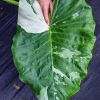Description
A Classic from the American SouthwestTexas Sage, also known as Leucophyllum frutescens, is a resilient evergreen shrub native to the Southwest United States and Mexico. It is characterized by its silver to gray-green leaves and vibrant purple or lavender blooms that typically appear after summer rains, earning it the nickname “barometer bush.”Caring for your Texas SageThis drought-tolerant plant is well-adapted to arid desert environments and thrives in well-drained soil under full sun exposure. Its hardy nature, paired with its stunning display of flowers, makes it a popular choice for xeriscaping or adding a touch of color to rock gardens.Texas Sage is also a favorite among pollinators, including bees, hummingbirds, and butterflies, enhancing its value for biodiversity. Despite its minimal care requirements, it offers high aesthetic appeal throughout the year.LightTexas Sage thrives in full sun, needing at least six hours of direct sunlight per day. Though it can tolerate some partial shade, a lack of sunlight may impact its growth and blooming frequency. Therefore, when planting Texas Sage in your garden, choose a location that gets plenty of sun.SoilThe plant is not particular about the soil type, but it does need well-drained soil. Texas Sage is adapted to the arid, desert-like conditions of its natural habitat and doesn’t tolerate waterlogged soil. If your garden tends to retain water, consider amending the soil with sand or small gravel to improve drainage or plant Texas Sage in a raised bed.WaterOne of the biggest attractions of Texas Sage is its drought tolerance. Once established, this plant can survive on minimal water, making it an excellent choice for water-conscious gardeners or those living in arid climates. However, during the first few weeks after planting, Texas Sage should be watered regularly to encourage a strong root system.Once established, the shrub can be watered every two to three weeks in the summer, and even less in the winter. It’s better to underwater Texas Sage than to overwater it, as its roots are susceptible to rot in consistently wet conditions.FertilizerAs for fertilizing, Texas Sage is well-adapted to poor soil conditions and typically doesn’t require additional nutrients. In fact, overly rich soil or excessive fertilizing can lead to rapid, lanky growth and fewer flowers. If your soil is particularly poor, a slow-release, low-nitrogen fertilizer can be applied in the spring, but this is usually not necessary.PruningPruning can be done to maintain the size and shape of your Texas Sage, but it’s important to note that the plant has a natural rounded shape and blooms on new growth. Over-pruning or pruning at the wrong time could result in fewer flowers. The best time to prune is in late winter or early spring before new growth begins.When pruning, avoid shearing the plant into geometric shapes. This not only gives the shrub an unnatural appearance but also encourages growth only at the tips of the branches, resulting in a dense outer layer that shades the interior of the plant. Instead, selectively thin out branches to maintain the plant’s natural shape and promote airflow and light penetration.Pests and DiseasesTexas Sage is a relatively disease-resistant plant, but it can be prone to root rot if the soil is not well-drained or if it’s overwatered. Ensuring the right watering schedule and soil composition is the best defense against this issue.As for pests, Texas Sage can occasionally attract whiteflies or spider mites, especially when grown in greenhouse conditions or during particularly hot, dry summers. Regularly inspect the undersides of the leaves, and if pests are spotted, treat the plant with a gentle insecticidal soap or neem oil.





